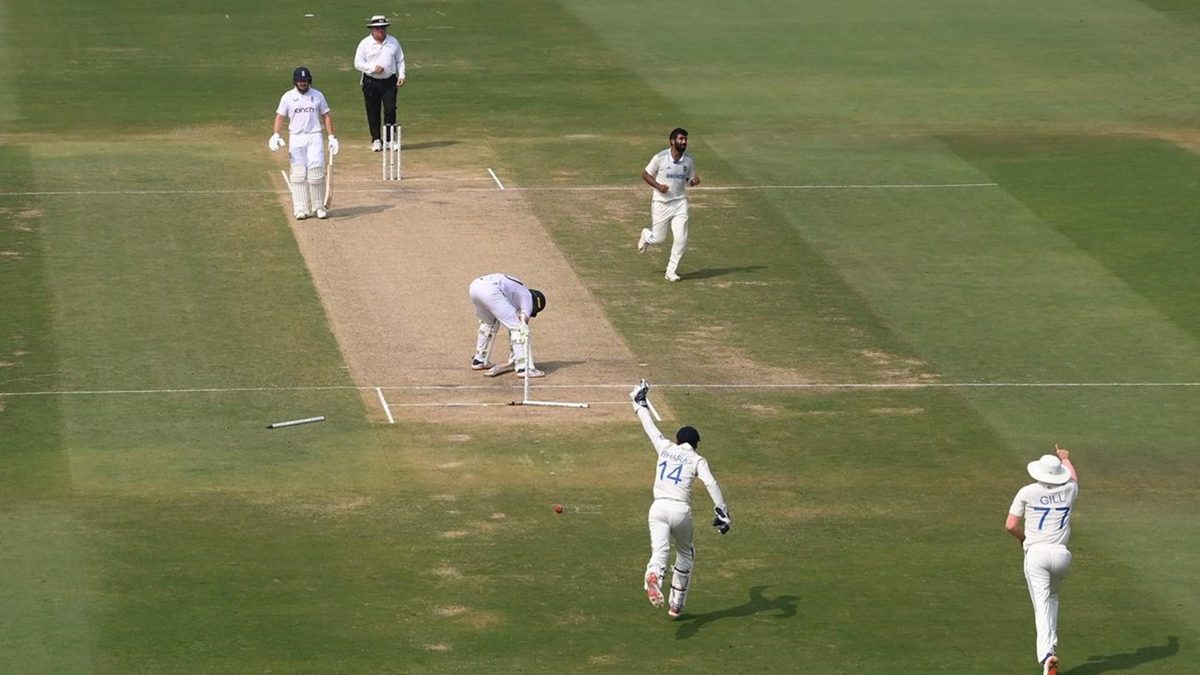
At Hyderabad and Visakhapatnam, Jasprit Bumrah demonstrated why he is one of cricket’s all-time greats.
Subscribe to the Wisden Cricket YouTube channel for post-match analysis, player interviews, and much more.
Unless you have been living under a rock, you have seen the clip – and photographs, from both angles – of the stumps lying spread-eagled after Jasprit Bumrah castled Ollie Pope with a yorker at Visakhapatnam.
You have also seen him produce two ridiculously good balls, one in each Test match, to clean up Ben Stokes. Or the in-out-in-out sequence that got Jonny Bairstow. Or the beautifully disguised slower ball to remove Ben Foakes just when he and Tom Hartley were beginning to make Indian fans feel slightly uncomfortable.
Just moments, you may say. A remarkable delivery or even a searing spell may determine what we remember cricketers by, but they do not reflect the long intervals between those moments that endure.
That makes sense, but then, Bumrah’s 15 wickets are the most from either side in the ongoing series. He averages 10.67, has struck every 23 balls, and has given away 2.76 an over. For India, the next-best are 32.75, 48, and 4.08. In other words, he has been the most miserly and the most devastating of all Indian bowlers by some distance. This is not an ordinary group either, for he was competing with six men with career averages under 29.
To add to that, there has been only one instance of an Indian fast bowler taking even 10 wickets at a lower average in a home series – Bumrah himself, against Sri Lanka in 2021/22.
[breakout id=”0″][/breakout]
Just one series, you may say, but Bumrah’s 155 Test wickets have come at 20.19 apiece. The only other bowler with 150 scalps at a better average is the legendary Syd Barnes, who last played a Test match more than a century before Bumrah had debuted.
Only four men have a superior strike rate than Bumrah’s 44.5. And since 2000, only four fast bowlers have a better economy than his 2.71. All that establishes – at the cost of repetition – he belongs to the upper echelons of both strike bowlers and containing bowlers.
Bumrah’s numbers seem even more spectacular when assessed around the globe. His 32 wickets in Australia have come at 21.25. Among touring fast bowlers in the last hundred years, only Richard Hadlee and Curtly Ambrose have as many wickets there at better averages.
In South Africa, Bumrah has 38 wickets at 20.76, and is bettered only by the ubiquitous Barnes. In the West Indies, he has 13 wickets from two Tests at 9.23 – a small sample, but the best in history. In England, his 37 wickets have come at 23.78, the best for India for anyone who has played more than three Tests in the UK.
And in India, often considered the graveyard of fast bowlers – teams (like England in 2024) sometimes pick only one pacer in an XI – the average of 13.06 (for 29 wickets) is the best irrespective of nationality or style of bowling.
Only in New Zealand does he average on the wrong side of thirty. He has toured the country only once – for a series the hosts swept 2-0 – and even there he did follow the 1-89 in the first game with 5-101 in a Test where India got only 13 wickets.
It is not about the one format either. In ODIs, Bumrah’s 149 wickets have come at 23.15. In the 21st century, only three fast bowlers have more wickets at a better average, and Glenn McGrath, Brett Lee, and Mitchell Starc all hail from a country where the venues assist pace bowlers.
And since the start of 2010, no fast bowler in the world has bowled more balls in ODIs than Bumrah at an economy rate matching his 4.59.
Switch to T20Is, and his economy of 6.55 is the best among fast bowlers from ICC Full Members. Expand it to all Twenty20, and his 7.02 is the best after Dale Steyn’s 6.85. In the powerplay, when the field is up, he goes for 6.50, the sixth-best of all time. At the death, when they go on all-out rampage with nothing to lose, he is third, with 8.18 an over.
Whichever format you choose, Bumrah keeps showing up towards the top irrespective of geography and often phase of the innings.
Yet, even that does not tell the full story. Given his runs with injuries, India have tried to manage his workload, saving him only for the ‘big’ contests. Of his 34 Tests, 28 have been against ‘SENA’ countries. Of 89 ODIs, only 14 have been in bilateral series against non-‘SENA’ teams, home or away; in T20Is, that count reads 26 out of 62.
Thus, Bumrah has achieved what he has despite playing most of his matches against the strongest teams or in the prestigious multi-nation tournaments.
India have produced great fast bowlers before. The early Indian teams of the 1930s had an excellent pace attack. Javagal Srinath and Zaheer Khan were among the greatest of their respective eras, as is Mohammed Shami. And then, there was the towering figure of Kapil Dev, at various points the leading wicket-taker in the world in both Test cricket and ODIs.
But in terms of sheer versatility as a fast bowler, Bumrah has surpassed all of them; and across three formats, almost everyone else in history.








